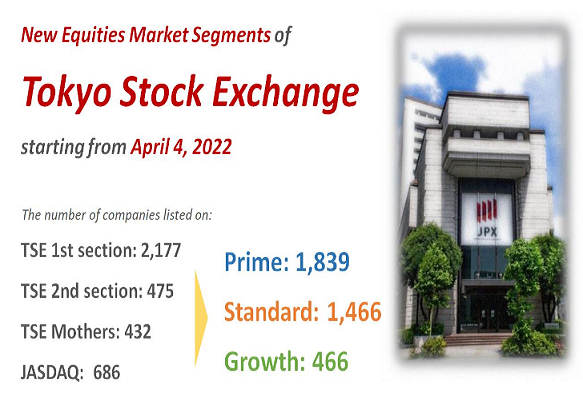TSE Cash Markets
Translating the market restructuring into investment opportunities: challenges for realizing the ideal state of the market

By Yukio Suzuki, CEO Chief Analyst, Belle Investment Research of Japan Inc.
From the viewpoint of investors, what differences will the new market segments make in their investment stance? I’m concerned about several points. First, is the Standard Market inferior to the Prime Market? Second, should the TSE have narrowed down companies qualified for the Prime Market? Third, is there any problem with listing on the Standard Market? Fourth, should companies achieve an early exit from the Growth Market? Fifth, since the TOPIX index has separate criteria, will natural selection occur?
How will a transfer to a new market segment affect the reputation of each company? While the TSE Second Section is often seen as less prestigious than the First Section, the Standard Market is independent from the Prime Market. Therefore, although there are differences in company size in these two segments, there should not be an impression that one is superior to another. If companies currently listed on the First Section find that the listing criteria for the Prime Market are too high, they have two options.
One option is that they could simply join the Standard Market, and aim at transferring to the Prime Market at a future date. Will this be interpreted as a drop in their status, and will they suffer adverse effects? How will they recognize the reputation? Will it affect their business transactions? Will their customers become reluctant to purchase their products/services? Will it demotivate their employees, and make it difficult to hire new employees? Will the corporate managers feel embarrassed when they attend an external meeting? I believe their market segment selection has little to do with such things.
Another option is that companies could take advantage of a grace period, during which they make efforts to meet the listing criteria according to their submitted plans. Even if they may not be able to satisfy the criteria soon, it is expected that many companies pursue this way. For example, if a company would like to maintain a market cap of 30 billion yen, where the price-to-earnings ratio (P/E ratio) is x15, it needs to secure net income of 2 billion yen, which would be equivalent to ordinary income of 3 billion yen. In the formula of PBR=ROE x P/E ratio (price book value ratio = return on equity x P/E ratio), when companies are expected to achieve ROE of at least 10%, PBR should be x1.5. Companies need to be able to aim at achieving such targets. Furthermore, this is not a goal: it is just a part of ongoing growth strategy. If companies are capable of transforming their business models, they can submit [to the TSE] their plans to meet the listing criteria for the Prime Market, and incorporate such plans in their medium-term business plans in order to achieve them.
On the other hand, for some companies, it is very difficult to meet the listing criteria. What would happen if such companies set high goals and aspire to join the Prime Market? Again, there are two possible scenarios. The first scenario is that it accelerates their business innovation, which used to be considered impossible. In this scenario, even if the bar is set high, it is worth challenging. The second scenario is that they formulate plans by setting the bar high, and keep failing to achieve the plans, thus losing credibility of the companies. Due to the unrealistic plans, they may pursue just short-term profit, and their basis of earnings and growth may be undermined. While it is essential to strengthen earnings power, if they merely take cosmetic measures, investors will find the lack of substance. From the companies’ perspective, there may be a growing frustration with increased cost because of the high bar. However, if corporate value increases, it will be recognized as prior investment, not cost. If they are reluctant [to make prior investment], they will not receive recognition from investors.
Speaking from the standpoint of investors, I think the listing criteria for new market segments could have been stricter. In order for the Prime Market to attract investors worldwide , it is necessary to raise the bar on growth and ESG in the listing criteria. It is suggested that companies which cannot successfully meet the criteria should not force themselves to apply for the listing on the Prime Market now, but should make steady efforts. The problem lies in a possible stream of the following companies: 1) companies which can smoothly join the Prime Market, and therefore, plan to make minimum efforts after the transfer; and 2) companies which desperately want to join the Prime Market, and make overstretched efforts for satisfying the listing criteria.
If there are many such companies, it will raise a question: what are the differences between the Prime Market and the TSE First Section? It may be perceived that there essentially are no clear differences. Solid companies have already met the listing criteria for the Prime Market. On the other hand, those which strive to merely satisfy the criteria cannot transform themselves into companies that increase their value. Then they will not bring about a change in the entire market. That means this market restructuring lacks the effectiveness.
In order to avoid such a situation, the TSE should continuously review its listing criteria and raise the bar. Consequently, the TSE should give a sense of tension to the companies that they may be screened out. However, I recommend that the TSE should not allow them to be merely transferred from the Prime Market to the Standard Market. What is important is the market’s “metabolism” where unqualified companies exit the market, and qualified new companies join the market. I’d like the TSE to work on revitalizing the market through the dynamism of such “metabolism”.
This market restructuring requires each company to transform its business model (mechanism to create value). They cannot take an easygoing attitude. Speaking from the standpoint of investors, we’d like to have a close look at details of corporate strategies for making innovative changes. There should be companies which will make a great leap forward. There we will find our investment opportunities.






